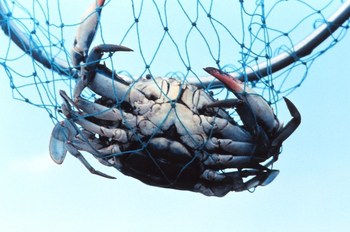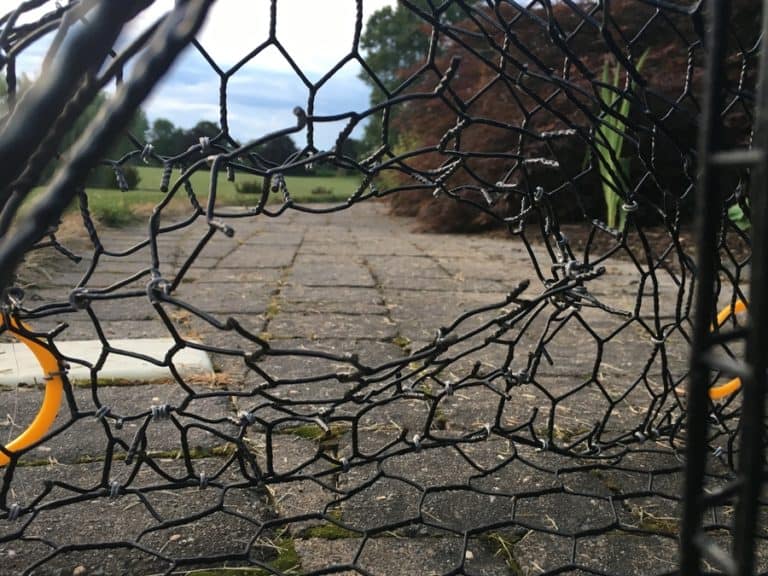How To Go Crabbing From Shore
If you find yourself without a boat or pier to go crabbing, you’ll have to go back to the basics. No crab pots or ring nets, today we’re using our wits, skills, and some chicken necks. I recommend using hand lines, also known as crab throw lines, to go crabbing from shore. They’re great for beginners and work best in shallow, sandy waters along the shoreline.
A baited string is the best way to go crabbing along a shoreline. Tie some raw chicken to the end of a few 15-foot lengths of string and cast the bait into the shallow water. Every 15 minutes, slowly pull in the bait and have a friend scoop up any crabs on the end with a net.
To a newbie crabber, this can sound like a bunch of mumbo jumbo. Let’s look into what hand lines are, how and where to use them, and some crabbing tips and tricks.
Pick The Right Spot
First, we need to narrow down the right spot. The phrase “from shore” can be pretty generic. For starters we cannot head to the rough ocean, it’s a bit too rough for handlines.
I recommend crabbing along the shore of an inlet, river, or canal that connects to the ocean. Basically anywhere with crabs in the water that doesn’t have rough waters and a strong current. It’ll make catching crabs much easier.
I live in Maryland by the Chesapeake Bay. I go crabbing along the Sassafras River where the waves don’t crash higher than your ankles. Crabbing here is much easier than, for example, the atlantic oceans where the waves can be taller than you.
Next you need to consider the terrain of the shoreline. Do you have easy access to the water? How long is the stretch of shoreline? I recommend at least 100 feet if you plan on catching enough crabs for a dinner.
Also, our traps will work best in flat, sandy-bottomed riverbeds (or seabeds if you’re crabbing along the ocean). Be sure to pick a spot with as little seaweed as possible, or anything that might get caught in your crab traps.
If you are lost on good spots to go crabbing, be sure to check out our State Crabbing Guides. They show you great public spots to go crabbing, as well as anything and everything you might need to know for a great crabbing trip.
Prepare For Your Trip
My motto is always be prepared. It’s pretty simple to go crabbing; it can be done with just some string and bait. However, extra supplies makes the trip much more relaxing and enjoyable for you and the family.
Frist, make sure you’re dressed for the trip. You’ll be near the river and dealing with pinchy crabs. Wear closed toed shoes and consider bringing gloves to prevent a painful pinch.
Also, dress for the weather. Sunscreen and a sun hat can go a long way.
Be sure to read our post on What to Wear On a Crabbing Trip.
You will need 3 to 6 hand lines for your trip. This is totally up to preference, but this is a good range to reference. Also, be sure to bring a dip net to catch your crabs.
Along with that, make sure to bring two coolers, one for your crab bait and one for the crabs you catch. It has to be large enough for the crabs to scurry around and not be stacked on top of one another.
How to use Hand Lines
Now that you’re prepared for your crabbing trip, let’s look into what hand lines are and how to use them.
Hand lines is a bit of a ‘formal’ for the crab catching method. Some call it chicken necking or just crabbing with a string. And it’s just that, you’re using a string to go crabbing.
If you live near the coast, you can sometimes find a hand line at your local Walmart. If not, they’re online at Amazon, Cabelas, Bass Pro Shop, and other outdoor realtors. Be sure to check nearby bait shops. They’ll have plenty of crab traps along with invaluable crabbing tips and tricks to share.
They’re unbelievably straightforward to use. Simply stick some bait on the clip at the end of the string, then throw it 10-30ft out in the water. Bait can be up to preference. Some great options are chicken gizzards, fresh fish meat, and other oily meats. Be sure to check our article on crabbing bait.
Setup several more lines along the shore 10 feet apart. The more traps, the more crabs.
Be sure to tie the end of the line to a stick and secure it in the sand so the crabs can’t run away with your lines. Leave some slack in the line. If you see it pull taught, you know a crab is trying to make off with your bait.
Once your traps are set, wait 5 to 10 minutes, then take a look at your lines. If they’re tight, run your finger along the line. If you feel jerks or bumps, you know a crab is on your line. This will take some practice, so don’t feel discouraged if you can’t tell for sure the first few times.
If you’re sure there’s a crab on your line, very slowly pull the line in. It has to be subtle enough so the crab won’t notice. Once you can see the crab take the dip net and scoop up the crab. It helps to have a friend nearby to help with this part.
Related Questions
Do I need a license to go crabbing?
In most cases, yes. Some states allow you to go crabbing with two to three hand lines, but it’s important to be licensed. To buy a license online, and check your state’s crabbing rules and regulations, check your DNR website.
When’s the best time to go crabbing?
Especially if you go crabbing from shore, it’s important to know when’s the best time to go crabbing. The best time is 1-2 hours before high tide all the way to 1-2 hours afterwards. One to two hours before and after high tide is known as slack tide, which is when the current is moving the fastest.
Blue crabs like to use the current to do the moving around for them, so they are out and looking for food at slack tide.




